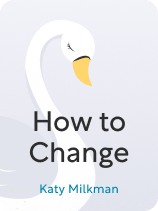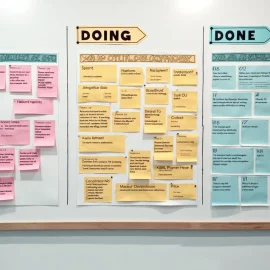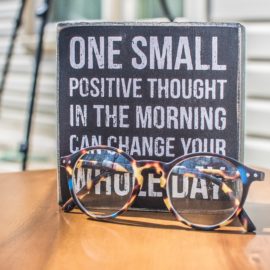

This article is an excerpt from the Shortform book guide to "How to Change" by Katy Milkman. Shortform has the world's best summaries and analyses of books you should be reading.
Like this article? Sign up for a free trial here.
Want to know how to make positive life changes? What does it take to make changes that stick?
To make positive life changes, plan the timing of your change well, develop self-confidence, and find peers who will support you and influence you for the better. Knowing how to make changes effectively can make a big difference in whether you achieve your goals.
Continue reading to learn useful ways to make life changes.
Change Requires Good Timing
Understanding how to change a behavior is only one piece of learning how to make positive life changes—we also need to understand when to do so. The best time to change a behavior is when you have the chance to start anew. Think of these moments as “new beginnings.” Put simply, a new beginning comes when a new date, event, or physical change offers you the chance to begin again.
Change Requires Self-Confidence
Having an effective strategy is one thing; knowing how to time it is another—but neither matters if you lack the self-confidence to successfully implement it. Believing in your ability to succeed can make or break any effort to change your behavior. This is because our expectations (or beliefs) about what will happen influence what transpires.
To do this requires that you create and automate new habits. You can do this fast by drilling the behavior you want to perform each day, sticking to it until it becomes your default. To reinforce the habit, reward yourself immediately after performing the new behavior. For instance, you might train yourself to go for a morning walk by committing to do so each day at 8 a.m. and ending each walk with a fresh coffee made to your tastes.
Some recommend that you build lasting habits on the foundation of new, identity-based beliefs. In other words, you’d decide that you want to be a particular kind of person, and then you’d practice the habits that make it true until you deeply believe you are that kind of person. This way your habits will root more deeply in your psychology and you won’t have to convince yourself to keep up with them as you’ve already become a person for whom they’re second nature.
To help reinforce your new habits, Milkman offers a few additional tactics:
- Favor flexibility—research shows performing a behavior at a set time forms a more rigid, breakable habit than doing it regardless of timing. For instance, do your morning routine whenever you get up, and it’ll stick better than if you do it strictly at 7 a.m.
- Chain together good behaviors—once you have one default habit in place, build another one off the end of it. For instance, you might extend your morning walk and coffee habit into a morning journaling session.
- Track your streaks—people who watch their progress build day by day tend to stick to their habits better than those who don’t. As an example, imagine the motivation that would come from seeing you’ve gotten up early for nine weeks in a row.
Following the Group
Pivoting to behavioral change at scale, we’ll now discuss how social norms have a strong influence on our behaviors. In short, we tend to go along with what our peer groups do, for at least one of two reasons:
- We want to fit in. Historically, being ostracized from the group could’ve meant death, so we’re wired to place a high value on group belonging.
- We assume the group knows something we don’t, and it’s probably beneficial to go along with them. For instance, you’d want to go along with your peers if there seems to be an office evacuation in progress, even if you don’t know why.
(Shortform note: In Behave, Robert Sapolsky explains that the cultures we’re born into condition us to behave in certain ways, value certain things, and obey the unspoken norms of the groups we belong to. Perhaps the core example of this is religion, which has been historically central to human cultures across the world. It also demonstrates two points. First, religions create strong in-group out-group dynamics, such that belonging is deeply important. Second, religious groups generally assume that there is some special or privileged knowledge, perhaps held by the priest class, and that it’s best to go along with those in the know.)
Social influence can have both positive and negative effects on our behaviors. To the positive, peers that we admire can motivate us to improve our behaviors. But if the gap between them and us is too large—if, for instance, you’re out of shape and friends with a dedicated gym rat—that sharp contrast could instead be demotivating.
You can use positive social influence to your advantage by surrounding yourself with peers who model behaviors that are just beyond your comfort zone. This way, you’ll find it possible to work up to their level. For instance, someone without any productivity habits might look to learn from someone who manages a few solid hours each morning—but not from the hardcore deep worker who’s been at it for years.
(Shortform note: This thinking relates somewhat to an ancient philosophical idea: friendships of virtue. According to Aristotle, who distinguished friendships of virtue from those of pleasure or utility, a friendship of virtue arises when you and another share mutual admiration for one another’s positive qualities or character traits. In effect, you motivate each other to become better. So when looking to use social influence to change your behavior, try thinking through your friends and relations to find someone with whom you might be able to grow and improve in tandem.)

———End of Preview———
Like what you just read? Read the rest of the world's best book summary and analysis of Katy Milkman's "How to Change" at Shortform.
Here's what you'll find in our full How to Change summary:
- An evidence-based approach to creating lasting change
- How to overcome common human failings, such as procrastination
- When the best time to enact changes in your life is






